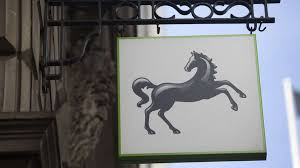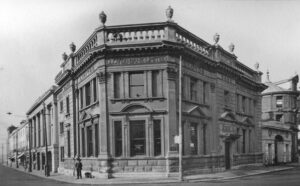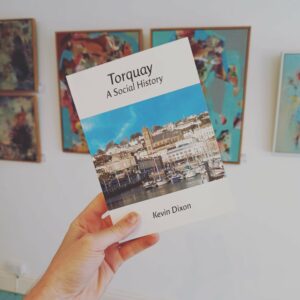As you travel along the Torquay Road towards Paignton, through Preston – from the Old English for ‘priest’s settlement’ – you come across a seemingly ancient building. However, although 306 Torquay Road may give the appearance of being over 500 years old, it was actually bult as a bank for Lloyds as recently as 1924.
However, although 306 Torquay Road may give the appearance of being over 500 years old, it was actually bult as a bank for Lloyds as recently as 1924.
While Lloyds, as an institution, does go back further than the 1920s, it is certainly not medieval either. The firm of Taylors & Lloyds opened as a private bank in Birmingham in June 1765. It was founded by John Taylor, Sampson Lloyd and their two sons. The Lloyd family were Quakers and, as such, were actively involved in the movement to abolish the transatlantic slave trade.
 Incidentally, the black horse symbol dates from 1677, when goldsmith and ‘keeper of the running cashes’ (an early term for banker) Humphrey Stokes adopted it as a sign for his shop. Humphrey’s business became part of the bank, Barnett, Hoares & Co. When Lloyds took over in 1884, it continued to trade ‘at the sign of the black horse’.
Incidentally, the black horse symbol dates from 1677, when goldsmith and ‘keeper of the running cashes’ (an early term for banker) Humphrey Stokes adopted it as a sign for his shop. Humphrey’s business became part of the bank, Barnett, Hoares & Co. When Lloyds took over in 1884, it continued to trade ‘at the sign of the black horse’.
The Lloyd’s Bank at 306 Torquay Road has been described as being influenced by the Arts and Crafts movement of the late nineteenth century. Arts and Crafts main protagonist was the designer and poet William Morris who was inspired by the art critic John Ruskin’s praise of Gothic architecture. Morris also critiqued the society he witnessed, particularly the monotony of factory production and the deskilling of workers, a process which he believed destroyed any natural creativity. His solution lay in the medieval past with its rich variety of ornaments and crafts that were rapidly being lost through standardisation.
But this tradition of recreating past building forms goes further back in Torbay, to when wealthy visitors brought with them Gothic Revival architectural styles. Beginning in the late 1840s, the Gothic Revival drew its inspiration from the pre-industrial rural landscape and its picturesque and romantic characteristics. As Torquay in particular prided itself as having both qualities, it was a fitting architecture for the rapidly growing and self-confidant resort. The Gothic Revival was more than mere fashion, however. It was a reaction: to the rise of evangelicalism; the industrialisation of Britain; machine production; the filth and poverty it brought; and even to change itself.
Locally the Gothic Revival style remained largely confined to domestic building. Victorian and early Edwardian Torbay was a highly competitive environment and so commercial premises favoured the established and familiar. Consequently banks replicated the Italian Baroque, characterised by elaborate and ornamental decoration; or the Classical, influenced by the architecture of ancient Greece or Rome. On the other hand, while too much innovation was perceived as perhaps risky, the architectural policies of the major banks do show some contrasts between themselves. Yet, whatever the minor variations in style, the idea was to always display solidity and safety to investors and savers.

Pictured are Lloyds Bank on Torquay’s Vaughan Parade in 1932; and Paignton’s Palace Avenue.
 Yet, after the Great War, architectural conservatism waned. By the time that Preston’s Lloyds opened in 1924, the bank had made some 50 takeovers to become one of the ‘Big Four’ clearing banks. Accordingly, as there were now fewer banks, there was perhaps less need for the competitive construction of large and ostentatious buildings.
Yet, after the Great War, architectural conservatism waned. By the time that Preston’s Lloyds opened in 1924, the bank had made some 50 takeovers to become one of the ‘Big Four’ clearing banks. Accordingly, as there were now fewer banks, there was perhaps less need for the competitive construction of large and ostentatious buildings.
This allowed more diversity. This period, roughly 1918 to 1930, was the heyday of the architecture of banking with designers following a variety of traditions. Hence, an American influence was noticeable in cities such as Liverpool and Glasgow. Older towns saw the construction of solid and authoritative stone medieval or Tudor-revival banks in suburban parades. Hence, the Torquay Road landmark.
Banks were once a common and necessary feature of every community. But during the early twenty first century they began closing their doors and disappearing from the high street. Customers were moving to online services to manage their money and using physical branches less and less. Banks were also looking for ways to cut costs, and terminating branches was an easy option.
The Lloyd’s Bank at 306 Torquay Road closed in 2015, to be followed by so many more Torbay banks in the following decade.
‘Torquay: A Social History’ by local author Kevin Dixon is available for £10 from Artizan Gallery, Fleet Street, Torquay, or:
https://www.art-hub.co.uk/product-page/torquay-a-social-history-by-kevin-dixon




























